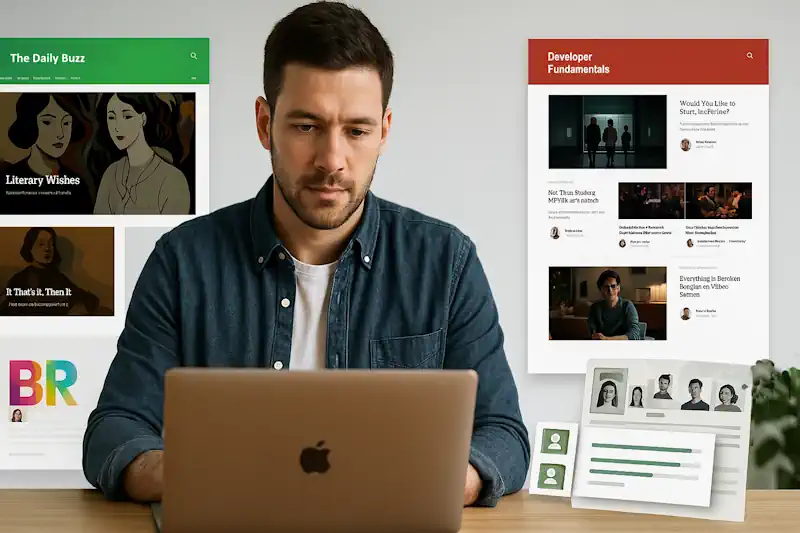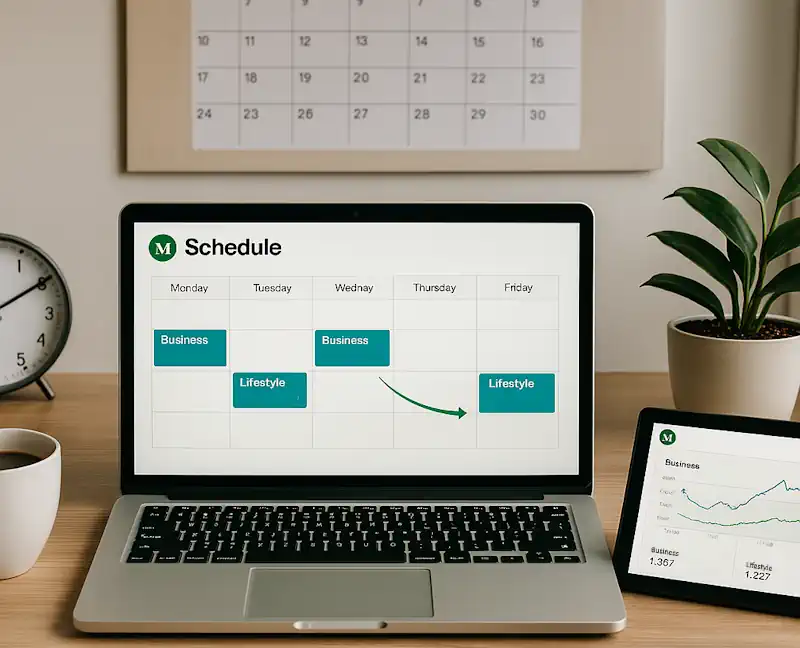What separates consistently successful Medium writers from occasional viral hits isn’t talent or luck—it’s a systematic approach to content strategy that most creators never implement.
Elevating Your Medium Strategy
Once you’ve mastered the basics of Medium—setting up your account, understanding the algorithm, and publishing consistently—it’s time to start thinking like a strategist. The platform isn’t static.

It shifts, evolves, and quietly rewards writers who do more than just post regularly. If you want to stand out over the long term, you need to treat your Medium presence like a content system.
That means optimizing what you write, when you write it, how you publish it, and what happens after it’s live. The difference between a hobbyist and a high-performing creator often comes down to how well they manage the details most writers overlook.
Leveraging Series Publishing for Reader Retention
One of the most overlooked but powerful features on Medium is Series publishing. This lets you group related articles into a sequence, much like chapters in a book. You control every part of it.
You choose the title of the series, the order of posts, and the theme tying them together. For readers, it’s a smoother experience than randomly stumbling onto your profile and guessing what to read next.
When someone follows a Series, they’re notified whenever you add a new installment. This makes it easier to turn one-time readers into returning ones. A great example would be “My 30-Day Medium Earnings Journey,” where each day you post a new lesson, stat, or insight.
By the end of the series, readers not only stay engaged, but they feel invested in your journey. That kind of connection builds trust and boosts your profile’s overall performance.
Creating Your Own Medium Publication
If you want even more control, creating your own publication is the next step. A Medium publication is essentially your own branded magazine within the platform. It gets its own homepage, cover image, logo, and editorial standards.
You can publish only your own content or invite other writers to contribute. If you’re running a business, launching a course, or building a community, this gives you a hub to anchor your content.
Unlike a series, which only involves your own writing, a publication becomes a platform within a platform. Readers can follow the publication directly, even if they don’t follow your individual profile.
That means your content can gain exposure even when it’s not personally trending. Publications like “The Startup,” “Better Marketing,” and “Towards Data Science” pull in millions of views because of their branding, contributor base, and consistency.

Data-Driven Topic Selection
Strategic topic selection matters more as you scale. Tools like Glimpse or BuzzSumo help you identify which topics are starting to trend but haven’t yet peaked. This gives you a head start on writing content that will be in demand in the coming weeks.
Instead of guessing what to write about, you’re using data to steer your strategy. For instance, if you notice a spike in interest around AI content tools for bloggers, you can create a how-to guide or a comparison piece before the space gets saturated. Being early matters more than being loud.
*To find evergreen, profitable topics beyond trends, check out Profitable Medium Topics: Strategic Niche Selection for Writers
Advanced Formatting Techniques
The way you format your articles also plays a huge role in engagement. Medium’s editor is minimalist, but that doesn’t mean you should treat it passively. Use bold type sparingly to highlight takeaway points.
Break up long paragraphs with dividers or pull quotes. Make sure your subheadings guide the reader through a logical path. You want someone to be able to skim your article and still grasp the core argument. Better formatting improves time on page, which improves your rankings across the platform.
The 80/20 Content Analysis
Once you’ve published a range of articles, look back at the ones that performed best. Apply the 80/20 principle—80% of your traffic and income likely comes from 20% of your content. Identify what those pieces have in common.
Are they all tutorials? Personal stories? Deep dives into niche tools? Once you know what works, double down. Keep 20% of your effort for experiments, but the rest should go toward scaling what’s proven effective.
Headline Testing Methodology
On the technical side, start every article with headline testing. Write five to ten potential headlines before choosing one. Use a headline analyzer tool if needed to measure clarity and emotional impact.
Avoid vague titles like “How I Grew My Business” and aim for clarity and curiosity—something like “How I Grew My Email List by 3,000 Subscribers in 90 Days Without Paid Ads.” Strong headlines don’t oversell. They invite.
Publication Timing Strategy
Strategic timing is another lever you can pull. Test different days and times to see when your audience is most responsive. For business and productivity niches, weekday mornings tend to perform well.
For lifestyle content, Sunday evenings often get strong engagement. Once you find your sweet spot, stick to it. Readers will begin to expect your content at a certain rhythm, and that consistency works in your favor.

Advanced Tag Selection Strategy
Tags are often an afterthought, but they shouldn’t be. Medium lets you add up to five per article. Choose tags with high reader-to-writer ratios. If a tag has 500,000 readers and only 2,000 writers, you’re entering a space with more visibility potential.
If the reverse is true—tons of writers, few readers—your article may get buried. Use Medium’s search bar to explore tag performance and test different combinations over time.
Meta Description Optimization
Optimizing meta descriptions is essential if you want to bring in traffic from search engines. While Medium auto-generates one from your first few lines, you can override this in the story settings.
Write a clear, benefit-driven summary of your article that encourages clicks. Think of it as your article’s elevator pitch for the open web. Beyond visibility, think about conversion.
Audience-Specific Lead Magnets
If you’re building a business off-platform, your Medium content should feed that ecosystem. One way to do this is by creating a lead magnet tailored specifically for Medium readers.
If your articles are about automation for solopreneurs, offer a free Notion dashboard or a downloadable checklist that complements the article. Link to it near the beginning and end. The goal isn’t to convert everyone—just to catch the attention of readers who want more.
Curation Optimization Strategy
Strategic curation can help your best work travel further. Medium allows you to nominate stories for curation when you publish. Don’t do this with every article—reserve it for your strongest content.
The editorial team looks for original thought, clean formatting, and relevance to current topics. If accepted, curated stories often appear in topic feeds, email roundups, and on Medium’s homepage. The lift in exposure can be substantial, especially if it aligns with a trending theme.
Strategic Content Repurposing
Once your content is live, don’t let it collect dust. Set up a repurposing system. Turn your articles into YouTube scripts, LinkedIn posts, Twitter threads, podcast episodes, or email series.
This extends your reach and helps you squeeze more value from every piece of content. You’re not just a writer—you’re a distributor. The more places your voice shows up, the more likely readers are to follow you back to Medium.

Premium Content Tier Strategy
Some creators go even further and build premium content tiers. These might include paid newsletters, private communities, or full digital courses that tie back into your Medium work.
Use free content to build interest, then funnel readers into your deeper, paid offers. You can do this by adding a CTA like “Want to go deeper? Join my workshop on X” or “Get the full guide here.” Medium doesn’t restrict outbound links, so use that freedom to guide readers toward your higher-value assets.
Data-Driven Performance Analysis
Medium also gives you access to performance metrics, and most creators barely glance at them. Dive deeper. Track which articles bring in the most followers. Which ones lead to email opt-ins?
Which ones keep people reading to the end? Use this data to decide what to write next. Set a monthly review where you analyze the past four weeks of content and adjust your strategy. If a topic flopped, figure out why. If something exploded, do it again with a new spin.
A/B Testing Framework for Medium
Don’t stop there. Build an A/B testing mindset into your process. Try different article lengths, headline types, or narrative styles. You might find that short, punchy pieces outperform long-form guides—or the other way around. Test different lead-ins. Swap out CTAs. Change publishing times. Medium won’t tell you exactly what to do, but it will give you enough data to test and iterate intelligently.
Algorithm Adaptation Strategy
Finally, every platform changes. Medium has had its fair share of algorithm tweaks, feature updates, and editorial shifts. If you notice a drop in views or engagement, don’t panic. Instead, go into audit mode.
Look at what’s changed. Did the tags you’re using lose relevance? Are your headlines underperforming? Are you still getting read through to the end? Talk to other creators. See if others are noticing the same trend.
Then adapt. Create a few experimental posts with different angles or formatting styles. Monitor them. The platform may reward what feels risky today, but will become normal six months from now.
Advanced Community Building Tactics
While basic engagement happens through comments and claps, advanced Medium users create community infrastructure around their content:
- Off-platform discussion spaces: Discord servers or Slack groups for deeper conversations
- Reader spotlights: Feature engaged readers in your articles (with permission)
- Collaborative brainstorming: Ask readers to contribute ideas for upcoming articles
- Shared projects: Invite readers to participate in challenges related to your content
- Community contribution publications: Create spaces where your most engaged readers can publish their own related content

This community-building approach transforms casual readers into advocates who actively promote your work to their networks.
*For networking strategies that complement community building, see Medium Networking Tactics To Amplify Your Content
Content Calendar Optimization
The most successful Medium writers use sophisticated content calendars that balance multiple factors:
- Topic cycles: Rotate through 3-5 core topics to maintain interest without repetition
- Content formats: Alternate between how-to guides, opinion pieces, case studies, and personal stories
- Engagement types: Mix high-utility content with high-emotion pieces
- Promotion windows: Time publications to align with your external promotion activities
- Series cadence: Schedule series installments for consistent release patterns
This systematic approach prevents creative fatigue while ensuring your audience receives a balanced content diet that serves different needs.
Medium API and Integration Strategies
For technically inclined creators, Medium’s API offers advanced possibilities:
- Automatic cross-posting: Set up systems to automatically publish blog content to Medium
- Custom analytics dashboards: Create comprehensive views that combine Medium stats with your other platform metrics
- Newsletter integration: Connect Medium engagement data with your email marketing platform
- Social automation: Trigger social shares based on Medium performance thresholds
- Content performance alerts: Get notified when articles hit specific engagement milestones
These integrations can save significant time while providing deeper insights into your overall content ecosystem.
The writers who stay ahead are the ones who treat Medium like a living system, not a static channel. They optimize every part of the experience—from what gets written to how it’s structured, shared, and measured. They think beyond the article and build processes around their content. If you do the same, your success on Medium won’t just be consistent. It’ll compound.
This was part 10 of our Medium series. Next, and last, in our series: Medium-Approved AI Strategies – Learn how to leverage AI tools appropriately within Medium’s guidelines. Or return to the intro and the full series’ Table of Contents.

